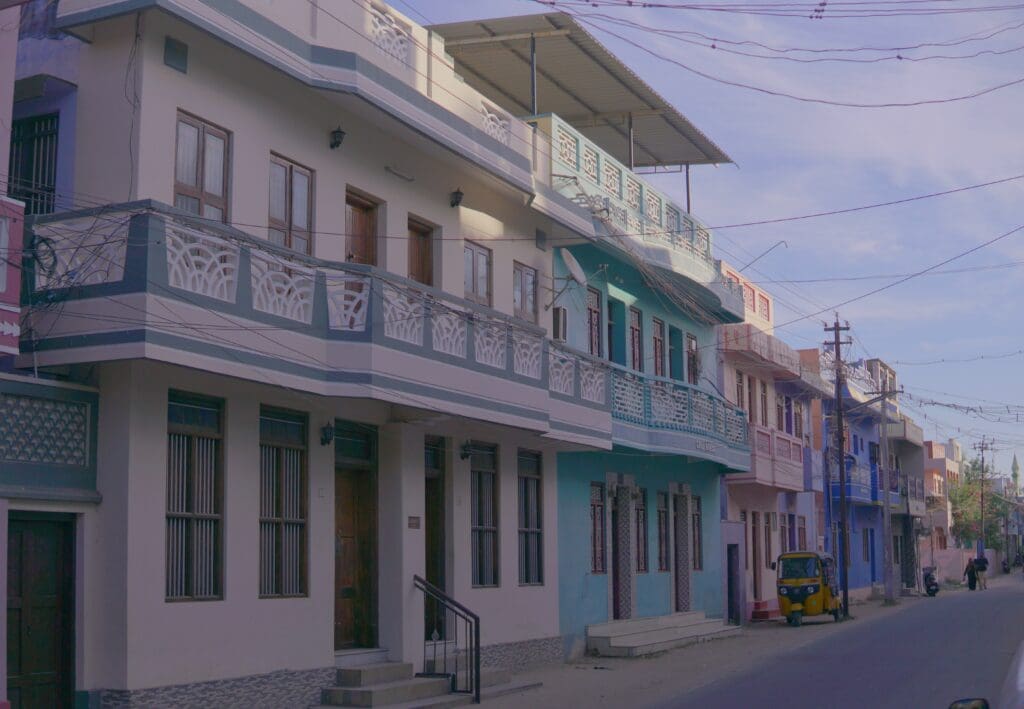
Having grown up in a small town, my exposure to the world outside has been very limited. Reading textbooks outside of the syllabi was neither encouraged nor discouraged in the setting where I was raised. Inadequate reading had kept me from the joy of knowing—knowing and seeing the multitudes of this world. I was already a mother when I first came to know that the house I live in is called Art Deco by architects and academics. Close to three decades of my life, I have been living in this ancestral house built in an Art Deco style in a coastal town called Kayalpatnam in Southern Tamil Nadu. The house was built in 1954, when it was in vogue in small-town India to have houses with curvilinear façades and terrazzo-floored interiors that otherwise could be seen in presidency cities like Bombay, facing the whitecaps of the Arabian Sea in Marine lines. My great grandfather who built the house, to borrow from Gyan Prakash’s Mumbai Fables where he writes about his father’s Art Deco house in Hazaribagh, “was not immune to the magnetism of Bombay”—courtesy his many business trips to the city in 1940s.
As a naïve child, leaning on the low-lying parapet, on the terrace of my ancestral house—its façade being the streamliner—I have fancied the visuals of other Art Deco houses that stand pasted to the sky in the neighbourhoods around. My favorite Deco houses were those that stood with kitschy majesty, with cup-and-saucer or water-pot shaped overhead tanks. Over time, the families that lived in those houses battered those structures to bring in other ugly structures. Before I declare them ugly, I am wondering if that is how Deco buildings as newborns were seen ugly by “heritage” practitioners from that now-also-dead-era.
Tanya George, a type designer and walk curator based in Bombay, in an interview to Art Deco Mumbai, an initiative aimed at documenting and conserving Art Deco structures in the city, said that her walks, among other things, enable participants to see through the reasons behind the design choices of types and letterings of business establishments without judgement on taste.
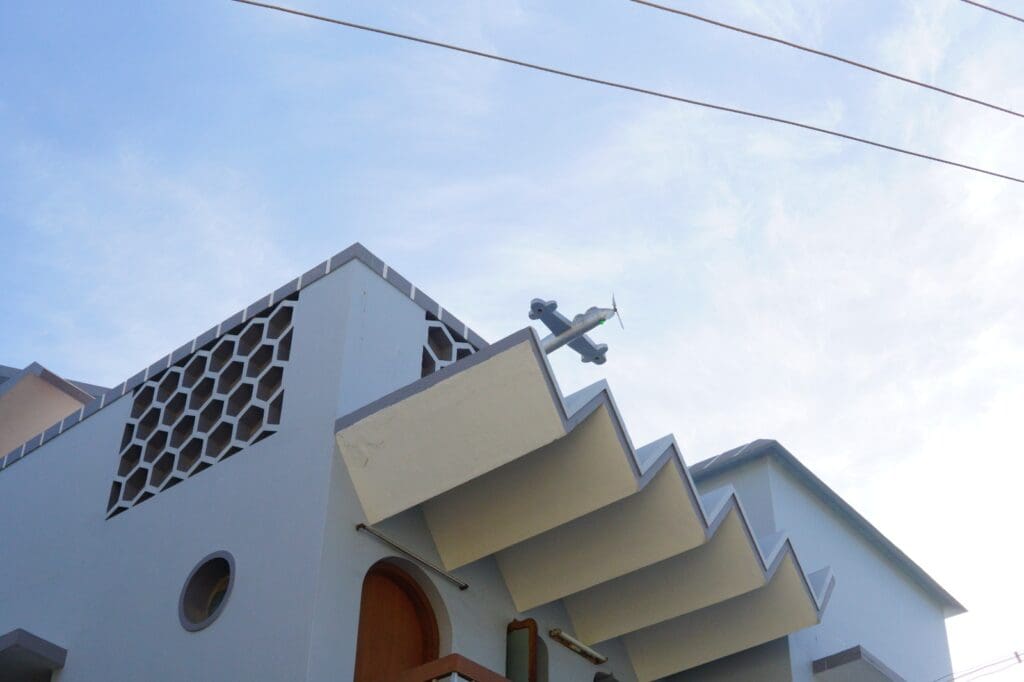

But architectural gestures are simply expressions of performativity. The homeowners who commissioned those Deco structures wanted theirs to be known as the neighbourhood’s piece de resistance. In small towns, and cities, among the small-time rich, Deco became a vehicle in an ongoing competition to outdo the other. The posterity like us is thus presented with vain structural gestures of cup-and-saucers, water-pots, aeroplanes, streamliners. An exhaustive amount has been written on Deco’s role in acting as a tool for nationalist, home-grown, and modern-day aspirations of the early 20th century India.
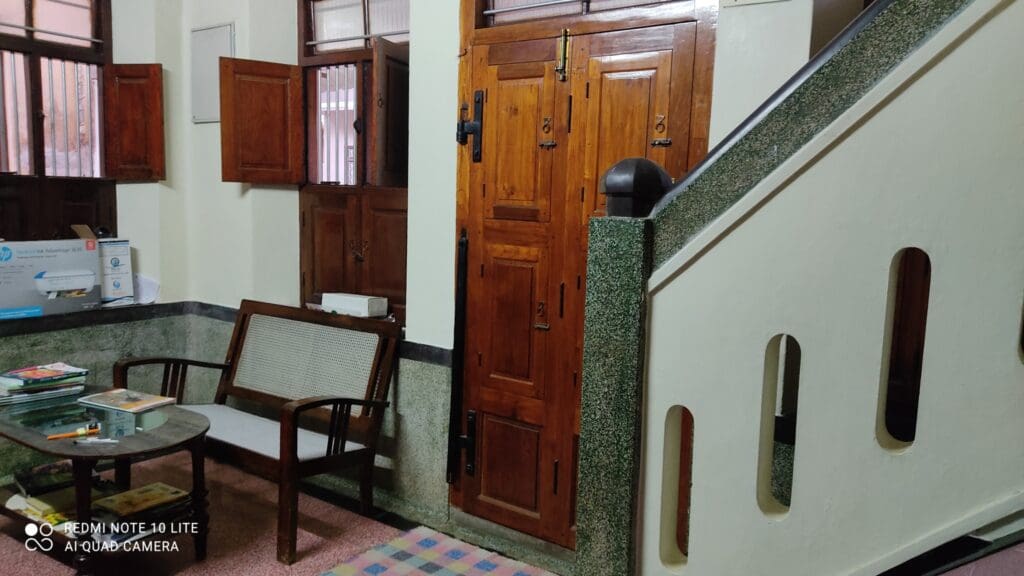

But, for a millennial like me, Deco is bygone. Not a relic but an active artifact to yesteryear’s modernity which is experiential in its concrete curves, and corners. Especially as someone whose childhood house is a Deco, I immediately experience moments of familiar domesticity seeing or stepping onto a terrazzo floored curvy cornered house or office. It acts as a synesthesia. I have experienced synesthesia as an abstract feeling without knowing the word while watching certain movies. The mainstream commercial cinema has barely any margin to echo one’s individual and complex experiences, but parallel cinema or middle cinema is a bag of treats in that regard. My impetus to synesthesia, I would later discover, is courtesy Art Deco visuals in many of the middle-cinema movies I had watched.
Undeniably, it is Basu Chatterjee, who captured Bombay’s magnetism in his visuals. There was a time when garish popular cinema was hell bent with binary understanding of urban spaces—larger-than-life bungalows against garbage aesthetics of cramped neighbourhoods with huts and thatches. Frames of Basu Chatterjee and Hrishikesh Mukherjee can today be declared as visual archives of spaces we have lost to the abyss of time.
It is the recurring Deco details that give his frames a timeless modernity, which fortunately happens to be the element my eyes recognize as home, a relationship almost umbilical. To the many oldsters today, these movies are a window to their poignant memory of the Bombay of yore when Deco was in its heydays, when Deco was state-of-the-art. It is no less than a visual archive of the city’s spaces that once held the nation in a fascinating stupor. Like Naresh Fernandes, in City Adrift, who talks of the urgency of his ‘Bombay walks’ to see the city’s sights before they get demolished, creators like Basu Chatterjee must have foreseen the potential demiseof the enthrall that Bombay once had. Perhaps, that motivated movies that were odes to the city and the Deco backdrop that followed its metropolitan cityscape.
Chhoti Si Baat (1976)
This is my most favourite of Basu Chatterjee’s movies, a movie that celebrates the love of two office-goers in Bombay where Arun (Amol Palekar), the hero, struggles with his repertoire of insecurities which keeps him from breaking his feelings to Prabha (Vidya Sinha), the heroine. There is another love story which the film keeps translucent—the director’s love for Bombay’s Art Deco. Take for instance, the neighbourhood right behind Marine lines facing the sea with low-lying compound walls, as if to exhibit a willful modesty despite the showiness of its luxurious design, standing recognizable with monsoon-fed mosses. Or the Gymkhana where Prabha plays table tennis. Windows with rounded and concentric patterns, the kind that was top-notch urbane at that time, are recurrent in the film. It rightly creates an inexplicable experience of modernity.
Even after five decades of its making, the freshness of the frames is timeless. It is spot-on for a Bombay-Deco confluence to visually and aurally experience on-screen; nothing short of a free heritage walk. The movie is an archive of an intangible Bombay dream that was. It was an era that first saw women office-goers in the locals and BEST buses, and office-romances that bubbled or fizzled at a bus stop.
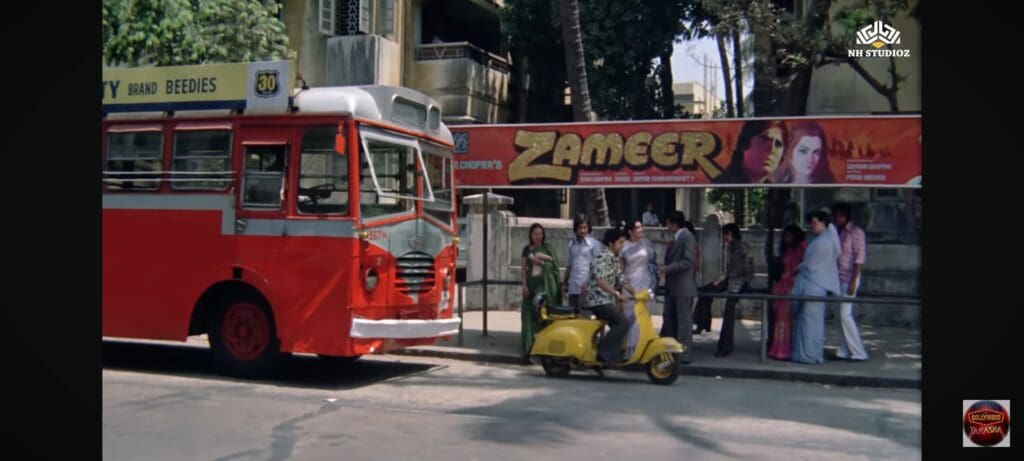

Most of the movie is shot in South Bombay, Marine lines in particular, which houses the largest number of Deco structures in the city, according to Art Deco Mumbai. In a scene, Arun stands close to broken at the backdrop of an array of Deco houses as his newly bought second-hand moped would not start, which was supposed to impress Prabha. In other scenes, they could be seen doing perfect Bombay things like eating at Samovar in Jehangir Art Gallery and asking her out to Gaylord restaurant at Churchgate for chai. Though Arun’s office is Indo-Saracenic, the telephone, typewriters, cubicles are all Deco, implicitly giving you a sense of old-world solemnity alongside the modern. Deco is, throughout the movie, an innate limb of the city. For a modern-day love story of the 70s, Deco has played a great prop to paint modernity and urbanity in the movie.


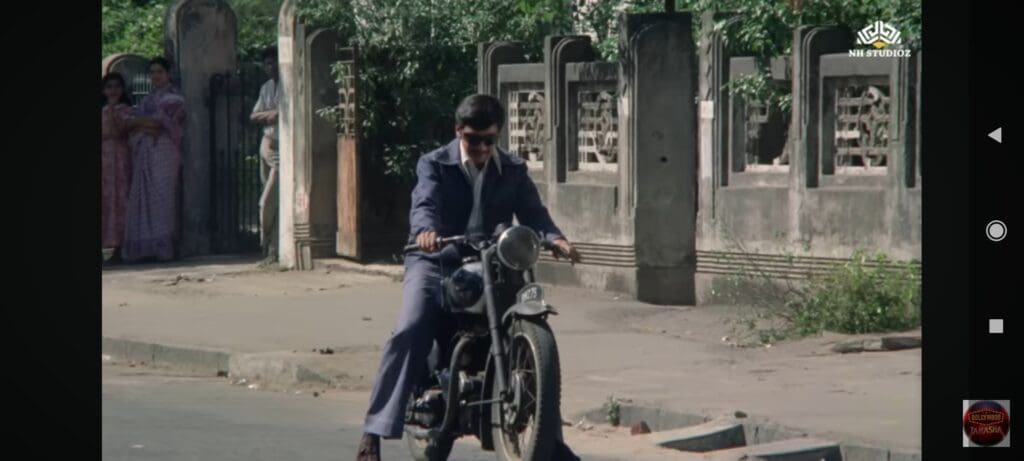

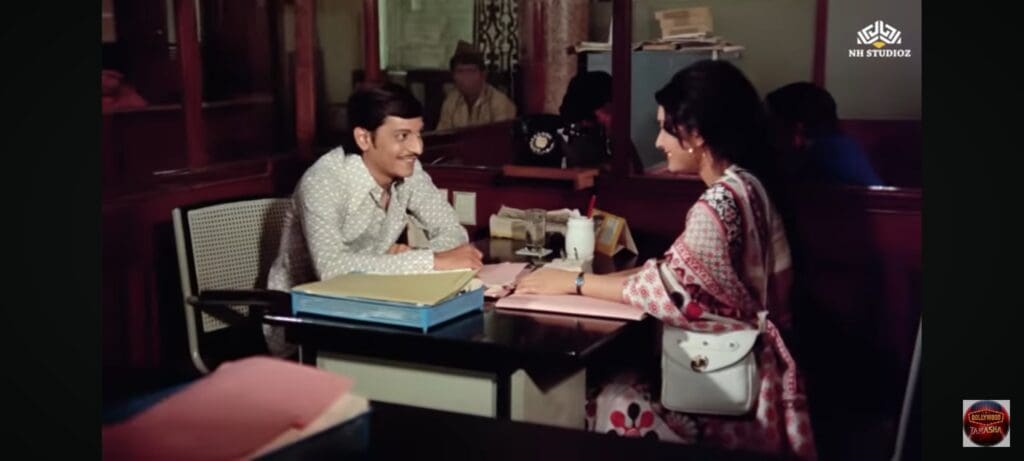

Gharaonda (1977)
If Chhoti Si Baat leaves you with a sense of utopia about the city, Bhim Sain’s Gharaonda is a just portrayal of the space crisis and thereof the corollary concerns. Sudeep (Amol Palekar) and Chhaya (Zareena Wahab) are colleagues-turned-sweethearts who land in a tragic loss of both money and love in their mission to find a space of their own in Bombay. Deco is at the heart of the story’s unfortunate flip. As an unmarried couple, they lurch around the city’s public spots from cinema theatres to beaches to bus rides, and restaurants.The question of marriage tows with itself the question of space, a better space, dignified, and thus Deco, unlike their present lives in the chawls. In a scene, Sudeep and Chhaya, at Bandra fort, sit with brochures of the front view plan of Deco apartments, envisioning their potential future in a tiny corner of those grand plans. Deco is used here for what it is best known–aspiration. But the infamous builder scams, among many other things the city is known for, befalls them and they lose their hard-earned money. Dejected by Deco dreams, Sudeep’s frustration and disorientation break their relationship. Deco here is at the core of the lethality of a relationship.
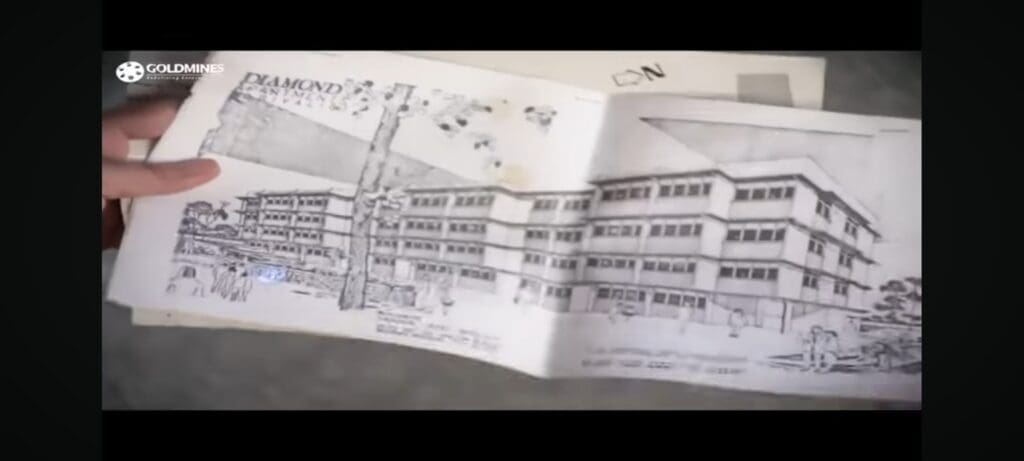

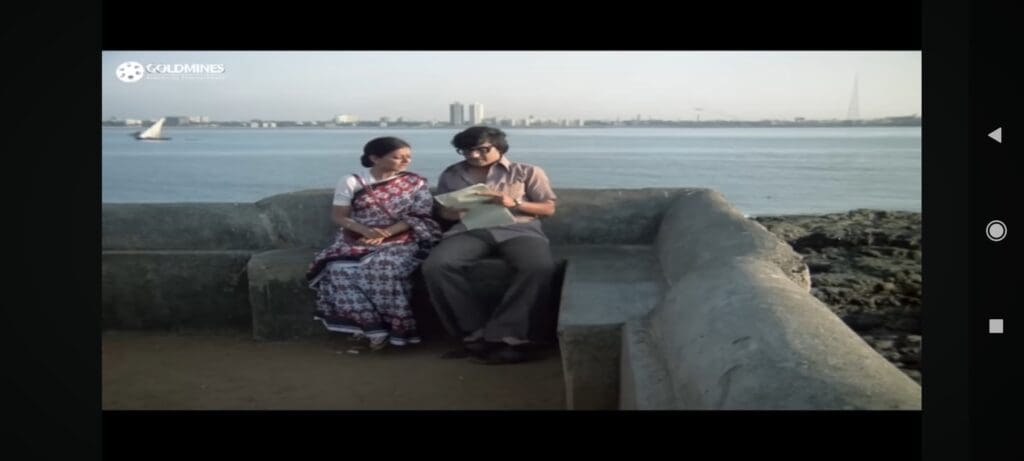



Damaad (1978)
This movie could easily be cancelled today for all the right reasons. Nevertheless, a mass trial even by the most woke may still go easy and be forgiving of it, given the times it comes from when political correctness was far in the future, yet to come, yet to be known. Deco’s presence as an idea of comfort in the movie is visually narrated. An unemployed Sharad (Amol Palekar) lives with his brother and sister-in-law in their city home, a Deco flat with all the comforts of a modern urban life. However, he willingly surrenders it for a good-paying job in a remote location in the hinterlands, far from the city, much to the disappointement of his brother. It sets the premise for the audience’s bemusement at his disdain on arriving at the remote rural location of his office.


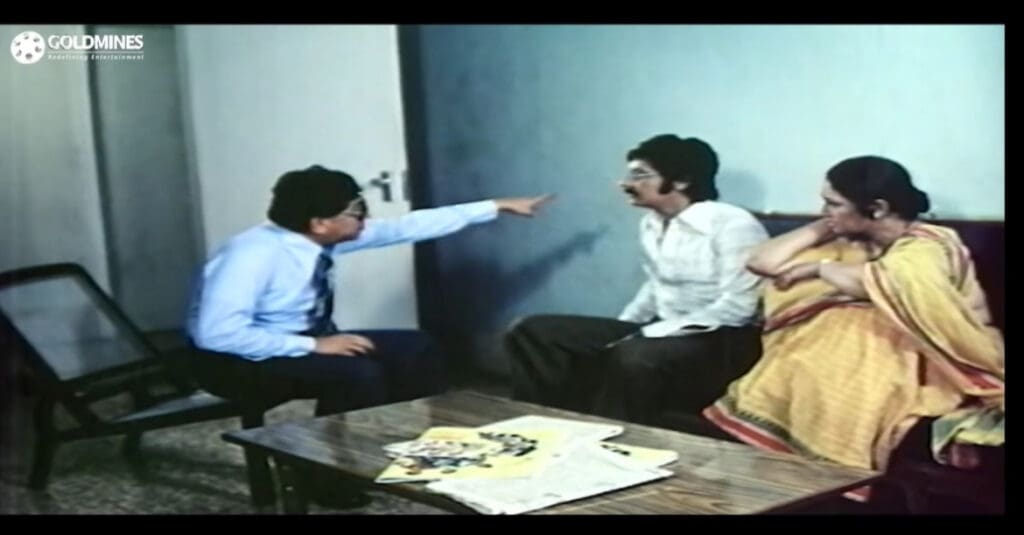

Baton Baton Mein (1979)
Basu Chatterjee’s love for Bombay did not end with his characteristic frames of the city. His idea of the city transcends beyond built structures and spaces. Though Deco and Bombay are permanent fixtures of his movies, this one is an ode to the East Indians of the city—the ones living there much before it took shape and assumed an urbanity. If you are finding the last sentence absurd for calling Bombay’s original inhabitants as East Indians when it is boisterously seated on India’s west, then this anecdote is for you: Many groups of Bombay’s early Catholics who were affiliated with the Portuguese—some claim a partial descent—rechristened their community’s name as East Indians to express their gratitude to the British East India Company on the occasion of 50th birth anniversary of Queen Victoria II. Most of them served the crown in various administrative positions.
As the movie is set in the Catholic villages of Bandra which predate many eras, phases, and mutations that the city’s circumstances put it through, Deco is far and few in the movie. The old styled bungalows with Mangalore tiled walls, attics, and rosewood furniture create meanings for the film’s framework. But certain elements like an Art Deco styled couch inside a Portuguese-styled bungalow and the Deco dining table which is a common site for heated debates on marriagefunction as symbols of changing times. The iconic “Baton Baton Mein” song and the many scenes where the protagonists meet in seclusion have in its backdrop Deco towers pasted to the city’s skyline. A long shot of Deco structures is a visual metonym of the city of Bombay itself. Passionate couples by the shoreline and a Deco decked skyline is a visual that will never get old.
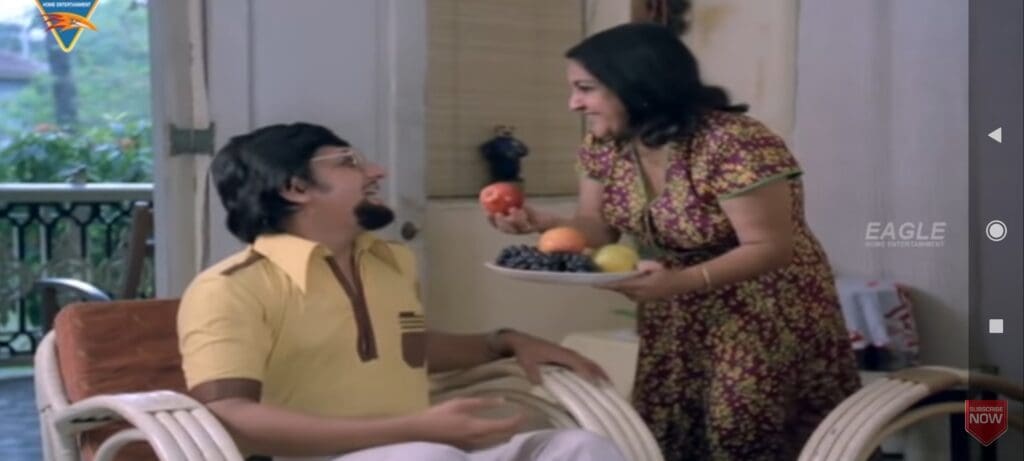



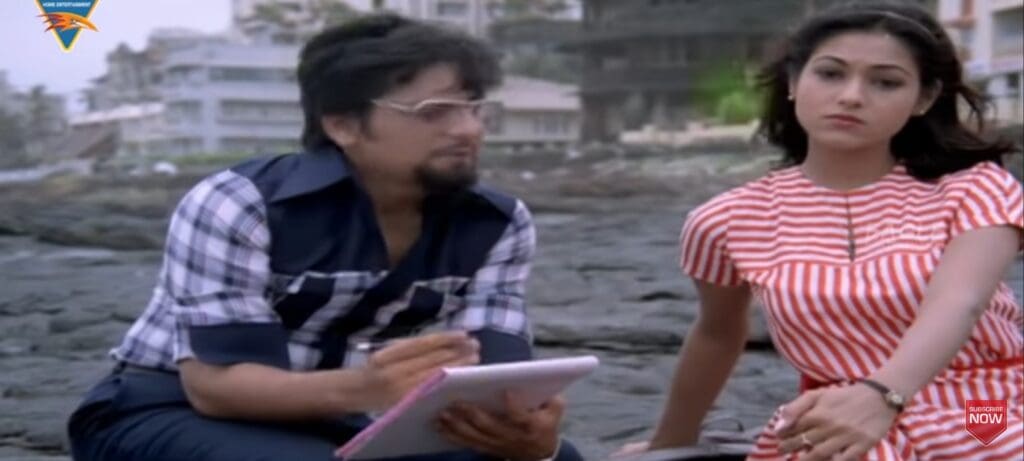

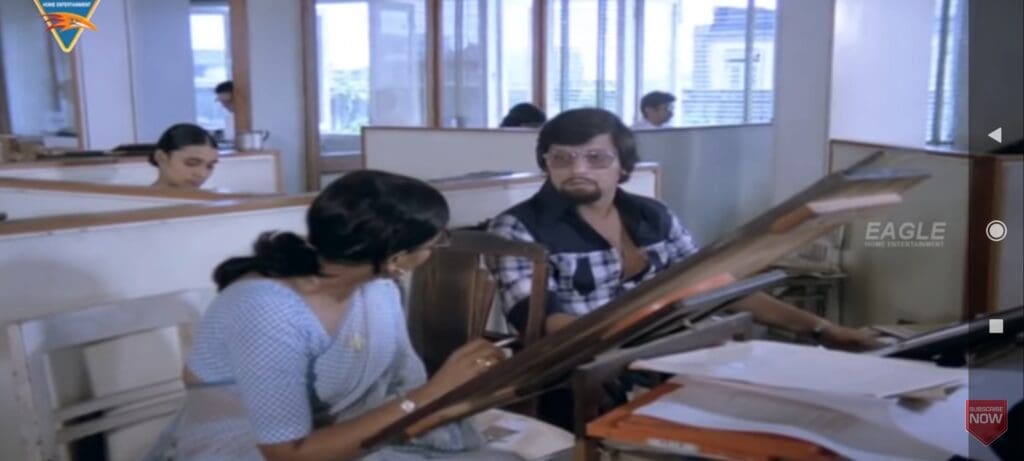



Apoorva Raagangal (1975)
This 1975 Tamil movie which can be translated to ‘rare ragas’ is directed by K. Balachander, popularly known as K.B. In 1975, two decades after the advent of color movies, K.B continued his fixation with black-and-white frames for his movies including this one. Even today the frames of the movie continue to fascinate me – certainly for its Deco. K.B in many of his interviews had said that to keep the narration of the story authentic, he preferred an out-and-out outdoor shooting. The entire movie is shot in two grand independent Deco houses symbolizing the stout wealth of the two elderly characters in the movie. In black-and-white frames, the two beautiful Deco houses create a visual experience of Madras’ spatial and sensorial themes with a rooted cosmopolitanism. Though most of the frames are shot inside the houses with prominent Deco elements like patterned grills, wall bands, and lawn area with Deco façades in the background, one feels the sensorial experience of Madras in the spatiality of the movie’s frames.
I can’t evade the topic of elitist upper middle-class urban aesthetics of K.B’s movies, and the ‘innocence’ of his vegetarian dieted characters which in my opinion have generously contributed to popular caricatured imagination outside Tamil Nadu that all Tamils are coffee-drinking pure vegetarians. Deco owners in real life Madras belonged to reserved neighbourhoods and were mostly upper caste drama company owners, Tamil cinema bigwigs—plainly the ones who can penetrate into refined socials and are often people themselves whom the masses would dream to hobnob with. In Chennai, even today, as one walks around the old neighbourhoods of West Mambalam, Mylapore, and Triplicane which are known for their strong Tamil Brahmin population, one would find old Deco houses ostentatiously half-covered by huge flowering trees elevating the space’s look from ordinary to lordly. According to an article in The Hindu, Asmitha Athreya, head of operations of a heritage venture called Madras Inherited, makes a crisp observation of early Deco owners being wealthy and then of Deco fever trickling to the landed class, and finally the middle class. This leads to another personal realization that, unlike Mumbai, Chennai’s Deco houses were mostly independent residences, often called bungalows. Apoorva Raagangal’s Deco house owners are said to be the relatives of one of the moguls of Tamil cinema industry A.V. Meyyappan –of the most famous A.V.M studios. All throughout the movie, the towering presence of Deco clearly shows us who’s who of the city.
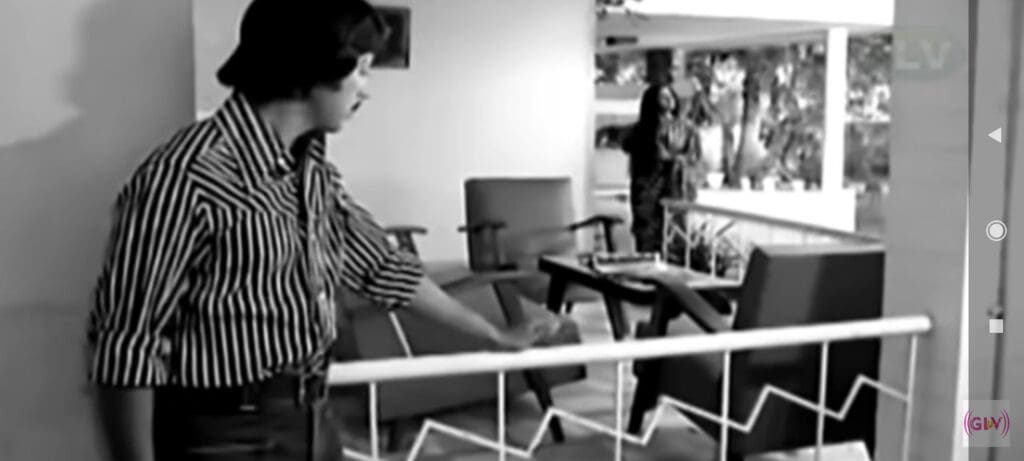

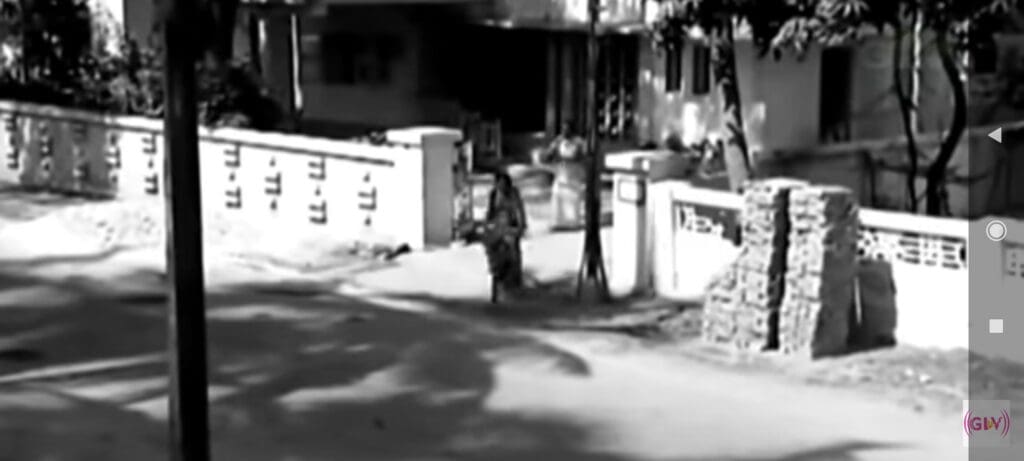

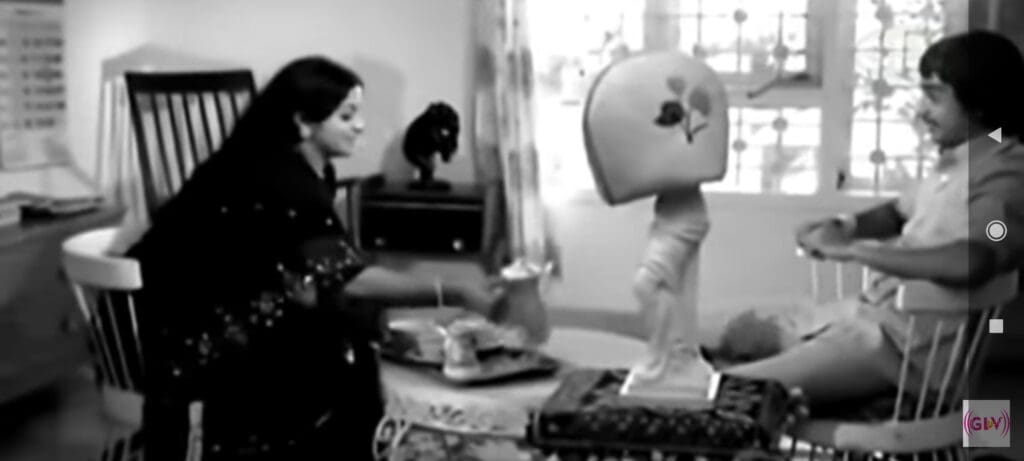

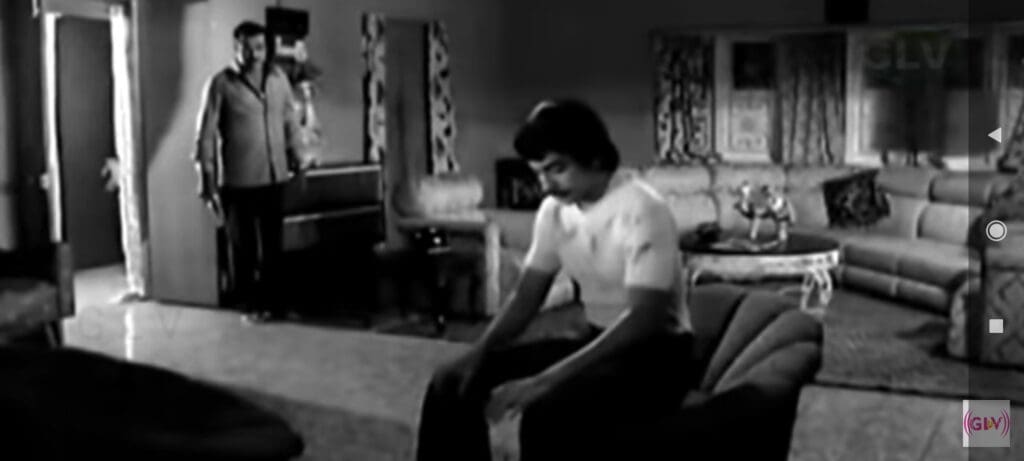

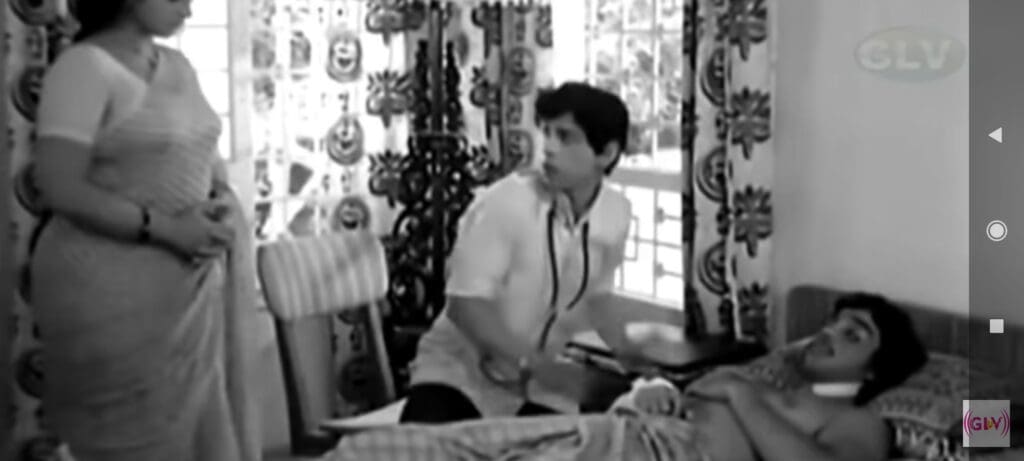

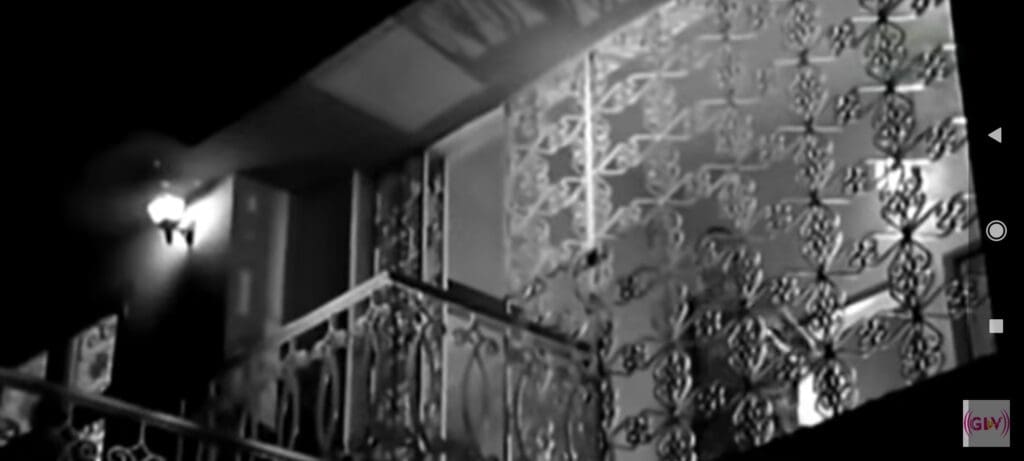

Thillu Mullu (1981)
Thillu Mullu brings me memories of the late 90s and early 2000s when I was home on holidays getting to experience a slice of television afternoons. The visuals of the movie transport me into Deco spaces that I have best known all my life. What I liked most in the movie’s visuals was the astute utilization of Deco spaces, to create an impression of largeness. Chandran’s flat,which is the first storey of a moderately large independent house,is Deco and so is his boss’ bungalow which is made to look like a futuristic space—adorned with wallpapers and shot at wide angles. .
In a frame, where Chandran’s uncle explains to him the ways to win his boss’ heart, where Chandran looks annoyed and confused. Behind him is a Tutankhamun piece. Tutankhamun and Deco are born twins. The Discovery of the Pharaoh’s tomb coincided the era of Deco’s initial days and the world, from West to East, went on a spree to have the Pharaoh’s icon on facades, as wall hangings, motifs on entrances, and elsewhere. In another frame, we see a window grill with jaali work of Goddess Saraswati. Native symbols, and icons are characteristics of Deco structures. Especially window grills like that in Madras at that time was a straightforward expression of everyday religiosity.
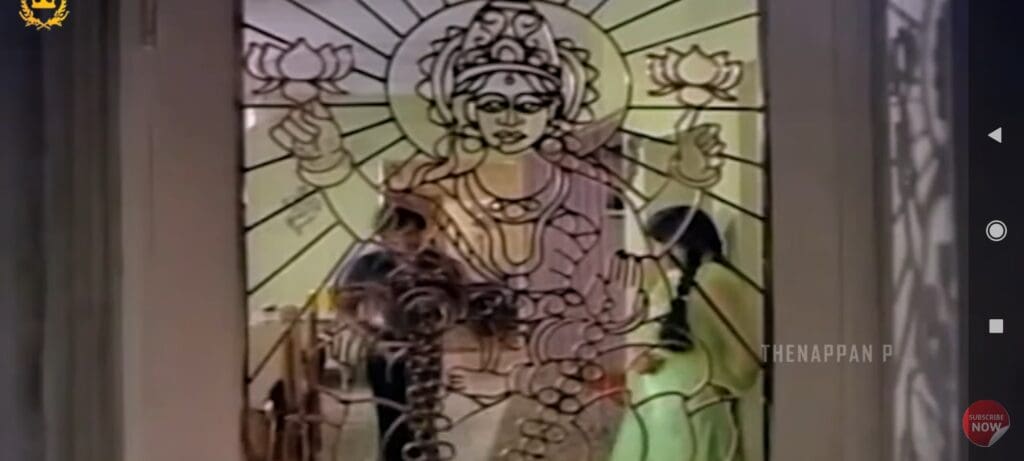

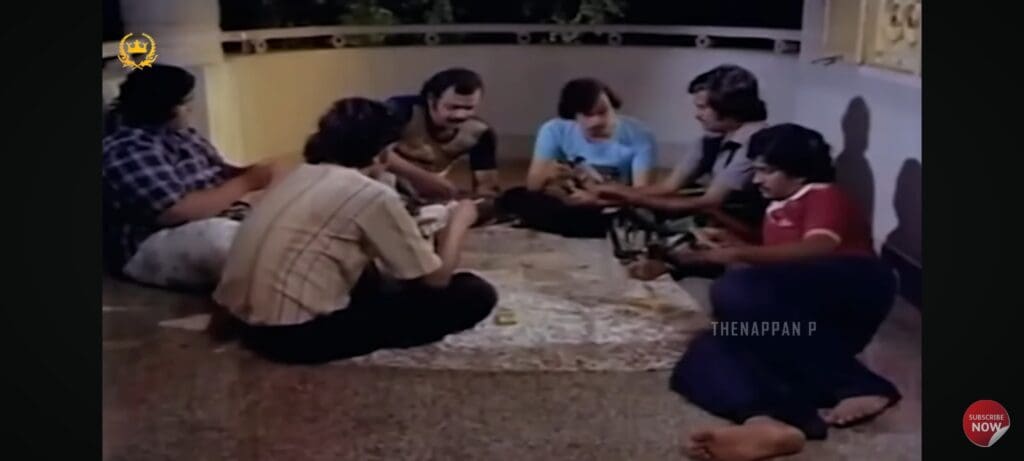

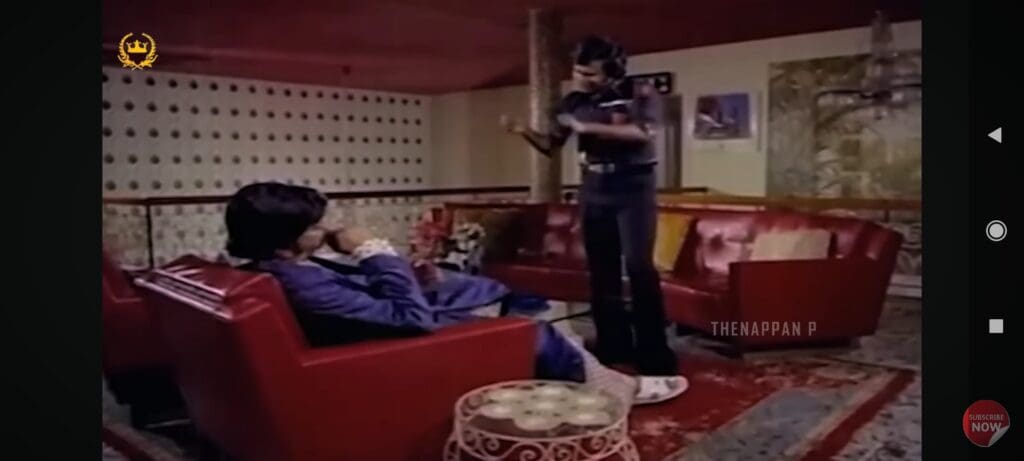

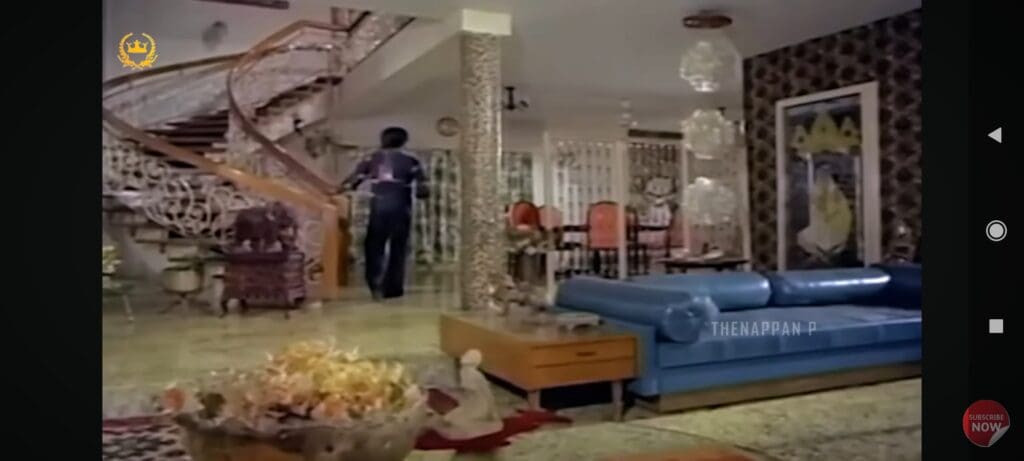

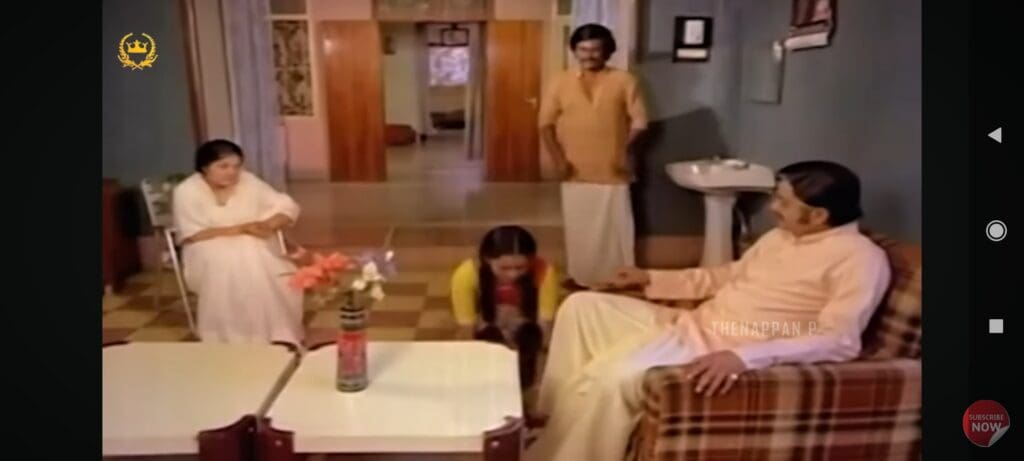

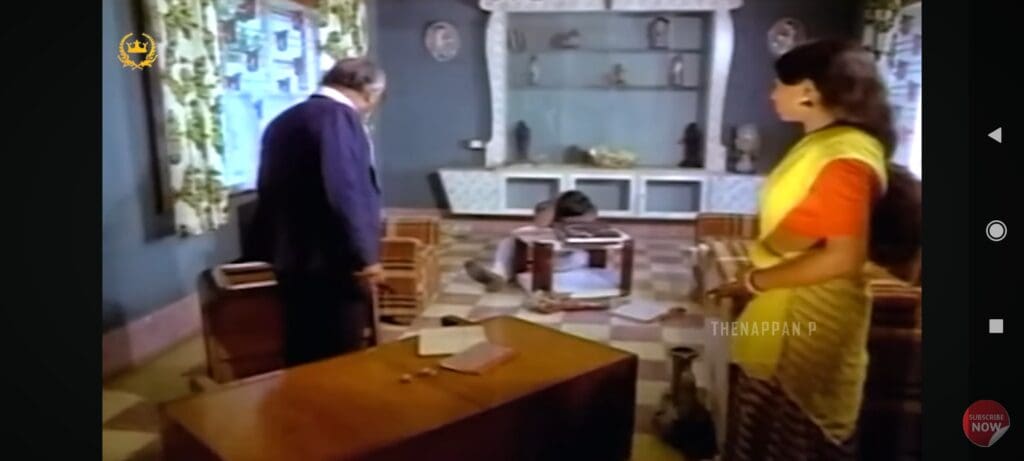

Some of the most interesting visuals are those heralding the comeback of vernacular iconographic expressions, symbols which were found only in millennia old temples. Moreover, the Madras Art movement was active in creating and marketing a visual culture that was local with a home-grown philosophy. In Madras, the movement was successful in creating a new kind of aesthetics that fused nationalism, sub-nationalism, classical projects in performance arts, and a new breed of connoisseurs, tied together by conforming to an emerging category of aesthetics for an urban middle class. Be it the occasional focus of frames on the Thanjavur dolls—a head spinning doll made in Thanjavur by traditional artisans—or the presence of nationalist leaders on the office walls in the movie, the new nation state’s newly found common symbols merged comfortably with Deco spaces.
Art Deco, which began as a movement in France, became a tool to display anti-colonial and pro-nationalist sentiments in India—making a marked shift in the streetscape of cities like Bombay. In cinema, it was used by creators to signal a motley of expressions that were often contradictory to one another. It is interesting how Deco spaces have been deployed to aid and create a wide gamut of visual expressions and storytelling. On a weak afternoon when there is little else to do, one can watch movies like these and soak in the memories of life that once was.
Sumaiya Mustafa is a writer of cultures, culinary practices, and stories that intrigue her. She has written for various publications, and is currently doing her research on littoral culinary practices and tastes as identity markers.



